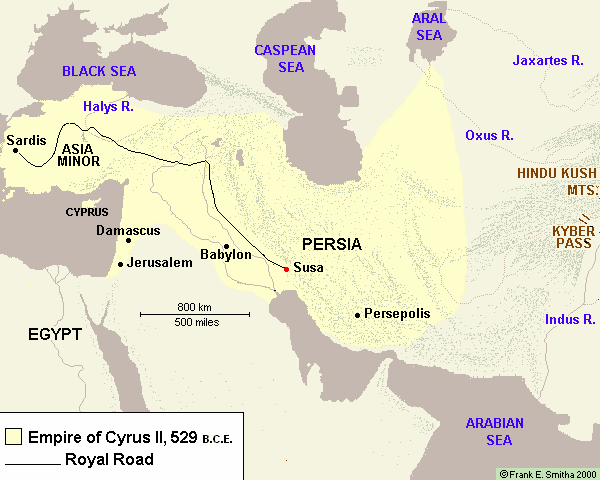The winter residence of the Persian kings. It stood in the district Cissia of the province Susiana, on the eastern bank of the river Choaspes. Its name in old Persian signifies "Lily," and that flower is said to abound in the plain in which the city stood.Susa was of a quadrangular form, 120 (or, according to others, 200) stadia in circuit, and without fortifications; but it had a strongly fortified citadel, containing the palace and treasury of the Persian kings. The Greek name of this citadel, Memnonicé or Memnonium, is perhaps a corruption of the Aramaic Maaninon, "a fortress;" and this easy confusion of terms gave rise to the fable that the city was founded by Tithonus, the father of Memnon. An historical tradition ascribes its erection to Darius, the son of Hystaspes, but it existed already in the time of Daniel (Dan. viii. 2). There is, however, a difficulty as to the identification of the Shushan of Daniel with the Susa of the Greeks.
The climate of Susa was very hot, and hence the choice of it for the winter palace. It was here that Alexander and his generals celebrated their marriage with the Persian princesses in B.C. 325, but the city declined after Babylon became the capital of Alexander and his successors. In B.C. 315 it was taken by Antiochus, who found in it a vast amount of treasure.
The site of Susa is now marked by extensive mounds, on which are found fragments of bricks and broken pottery, with cuneiform inscriptions. The ruins of the ancient city cover a space of nearly three square miles, and they have been carefully explored by Loftus, Churchill, Dieulafoy, and others. The principal remains that still exist are four vast platforms like those at Persepolis (q.v.), with traces of a gigantic colonnade with a frontage of over 340 feet and a depth of 240 feet. The palace of Darius Hystaspis has also been excavated, and from it many artistic treasures taken to the Louvre. See Jane Dieulafoy, La Perse, la Chaldée, et la Susiane (Paris, 1887); id. À Suse (Paris, 1888); Marcel Dieulafoy, L'Acropole de Suse (Paris, 1890-92). (Harpers Dictionary of Classical Antiquities, 1898)
